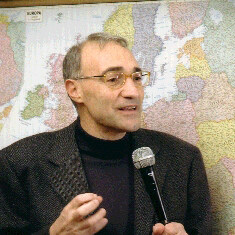The romantic mossy stones of Ruskin’s Venice and Charles Aznavour’s city transform to sadness when love vanishes. The contemporary Venice of old groceries stores and craftsmen’s workrooms have become junk goods bazaars, Pizza Huts, unfitting Irish pubs, masque and knock-off shops for the flood of millions distracted tourists.
Dwellings, once inhabited by families full of life, have been transformed into emotionless Bed & Breakfast’s booked online in order to provide a good income for former residents who have been forced to defect to the mainland.
The heartbroken, nostalgic Venetians feel helpless as they see their beloved city depopulate and perish, and yet at the same time struggle with the very thought of change. Churches, once a place of prayer, have been transformed into Godless museums with entrance fees. “Que c’est triste Venise”, they say wallowing in a defeatist and foreboding melancholia, while entrapped in a self-compliance of individual and cultural idleness that thwarts all possible change.
Currently, a collection of professionals and scholars are trying to break this collective depression. With renewed enthusiasm, ideas and projects to stop the city’s slow agony, they hope to transform it into a vibrant place for people who want to live there.
By designing a new human habitat, based on an updated interpretation of the contemporary society, this group of international scholars and professionals (architects, geographers, and economists) is working to provide the cultural groundwork to make Venice an example of a new city-life style.
For the past couple of decades, the old modern mass-society has morphed into a collage of real and virtual communities that have adopted diverse life-styles. Unfortunately, with age, the old modernists who grew up in mass society, and the very ones who boasted to be outward-looking, have got presbyopia.
They still imagine huge infrastructural constructions, devise metropolitan areas, and stubbornly think that all the problems can and should be resolved in one single manner, namely at a higher and higher scale. They don’t realise how they have lost ability to deal with details and do not perceive the increasing diversities of urban cities and the societies who populate them.
Through the presbyopia of old modernists, the vision of Venice is now as one city which includes the hinterland as well as the metropolitan area. This precludes us from recognizing that the very historical centre is made up of different neighborhoods (sestrieri) that in the past used to be towns with their own character, style, institutions and even with different accents.
Certainly, there is the mass tourism Venice that realistically cannot be changed and return it to the way it used to be at Ruskin’s times. If we look at it carefully, this part of Venice addled by mass tourism does not constitute the city as a whole, though it is definitely the noblest and most celebrated.
We can call it a sort of Disneyland, a copy of the Las Vegas Venetian and yet don’t give up mending the decay. Because we cannot return it to the beauty of the past, we need to generate present-day values as much as it is possible.
Aside this damaged Venice, there is a much greater one, unknown and quiet where people live differently from any other western city: no cars, silence and beauty with all the comforts that modern technologies allow. Venice neighbourhoods are not all the same: Celestia, Fondamenta nuove, Sant’Elena, each of them has its own character and none is affected by an injurious tourism.
The current focus must be on two special areas. In Giudecca and Castello, land is available for development and projects, inspired by the idea of attracting new residents and creating employment which is not necessarily connected to tourism. The new projects, based on updated social considerations, and not on old biases, drive to new projects.
We think of a vibrant Venice, an attractive milieu for young and creative residents who look for a unique lifestyle which is not available in other places and is connected with an unparalleled historical, monumental and cultural heritage. While carefully preserving the “Stones of Venice”, we need to build another, which is both the same and different, and revitalise it with new all-year residents. The city spells “change” and, without change, the city dies.
There must be a future for Venice. It must be based on:
(a) The attention to small scale design and plans, as well as the harmonisation with natural and man-made environments.
(b) The enhancement of traditions and life-styles nearly extinct (like slow and clean mobility) that now are possible again thanks to ICT technologies.
(c) A defined society and a new economy that can develop in a unique international environment.
(d) A new – and at the same time very old – idea of urban life, where energy is fully renewable, waste is smartly collected and recycled, and quality of life comes from a civil social interaction. Specifically, what a large part of the millennials dream of.
Let’s make Venice happy again! Let’s stop chasing the dreams of yesterday’s tomorrows and imagine we are already in tomorrow’s yesterday that is in our grasp.
Help us lay the intellectual foundations for a new radical politics. Sign up to get email notifications about anything new in this blog. See also our new book: Backlash: Saving globalisation from itself.




